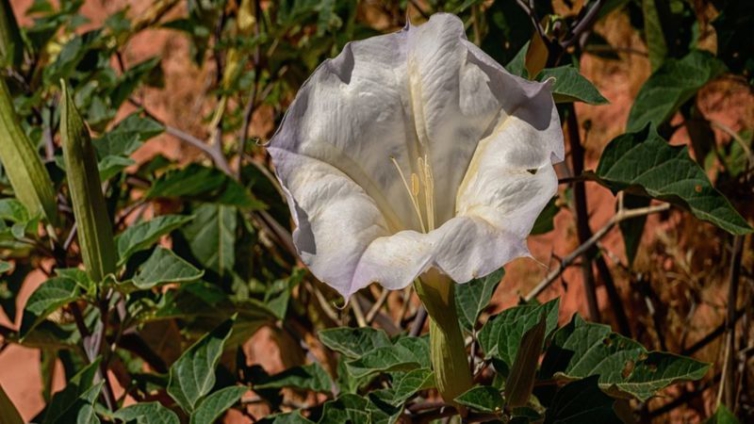Cave art in California created by indigenous Americans about 400 years ago depicts a hallucinogenic plant, according to new research.
Pinwheel Cave in southern California gets its name from a red, wheel-shaped drawing on its ceiling.
Researchers had previously discovered the chewed remains of plants, stuffed in crevices in the ceiling of the cave.
California cave depicts hallucinogenic plant, study finds https://t.co/MDvd9DL095
— BBC North America (@BBCNorthAmerica) November 25, 2020
Now the remains have been confirmed as Datura, a plant used historically for its psychoactive effects.
While many have believed that prehistoric rock art was influenced by hallucinogens, this latest research suggests that the rock paintings at Pinwheel Cave depicted the Datura plant itself, rather than any visions caused by the plant, the study said.
However, the findings do present "the first clear evidence for the ingestion of hallucinogens at a rock art site", the study, which was published in the Proceedings of the National Academy of Sciences, added.
"I was like: 'Wow, we found the smoking gun of hallucinogens at a rock art site,'" David Robinson, a lecturer in archaeology at the University of Central Lancashire who led the study, told ScienceMag.org.
The painting showed the artist was "representing the plant that causes the hallucinogenic experience - not the vision that is caused by the plant," Dr Robinson said, adding that "they're venerating the plant, saying: 'That plant's cool.'"
Sandra Hernandez, a Tejon tribal member who worked on the study, agreed that the art was depicting the flower.
"I kind of marvelled at the shapes that they captured in the rock art compared to the actual flower unfurling," she said.
The discovery of various different tools and food scraps suggest that the cave was likely a communal area, the researchers said, and the rock art could have been "acting as visual catalysts for communal experiences".
The artwork could have helped with "setting the scene", like religious artwork in other settings, to help people who were sharing the tradition of taking the hallucinogenic plant in that cave, Dr Robinson told Live Science.
Latest Stories
-
Afenyo-Markin offers apology to Dr. Ayensu-Danquah over “strange reasons” remark
14 seconds -
How Dr. Ayensu-Danquah cleverly evaded Afenyo-Markin at her vetting
26 minutes -
Dr. Ayensu-Danquah defends professorship, stating 15 years of teaching surgery
3 hours -
Access Bank honoured with two prestigious awards at 2025 HESS Awards
3 hours -
A/R: Aspiring nurse killed in Denase gun attack
3 hours -
Oti Region to get university within my tenure – Mahama reaffirms pledge
3 hours -
Kofi Bentil calls for abolition of regional ministers
4 hours -
Daughter killed in father’s arson attack over sex denial
5 hours -
GIHOC to undergo restructuring amidst crippling inefficiency and GH¢427m debt
5 hours -
NPA Scandal: Four suspects remain in custody after failing to meet bail conditions
6 hours -
NPP to open 2028 flagbearer nominations on July 29
6 hours -
Sam George to open Pan-African AI Summit 2025
7 hours -
NDC opens nominations for Akwatia parliamentary primaries on July 28
7 hours -
Guinness Ghana DJ Awards opened new doors for my career – DJ Pho
8 hours -
Mohammed Sukparu commits to advancing Ghana’s Artificial Intelligence agenda
8 hours

